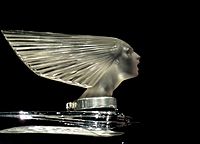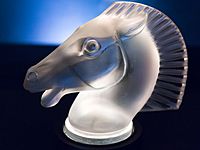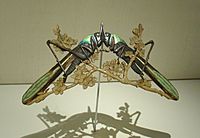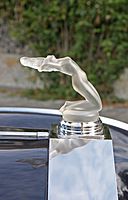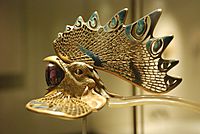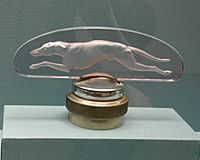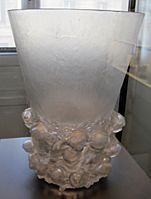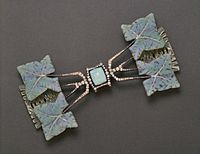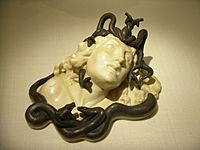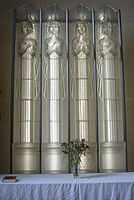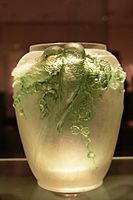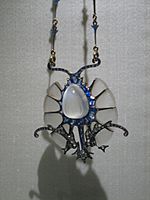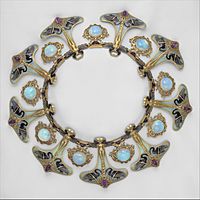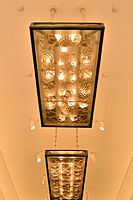René Lalique facts for kids
Quick facts for kids
René Lalique
|
|
|---|---|
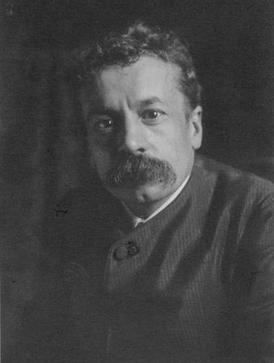 |
|
| Born | 6 April 1860 Aÿ, Marne, France
|
| Died | 1 May 1945 (aged 85) Paris, France
|
| Alma mater | Collège Turgot, Ecole des arts décoratifs, Crystal Palace School of Art |
| Known for | Glass art |
| Spouse(s) |
|
René Jules Lalique (born April 6, 1860, died May 1, 1945) was a famous French artist. He was known for making beautiful jewellery, but he became even more famous for his amazing glass art. He designed many things, like fancy perfume bottles, vases, chandeliers (big hanging lights), clocks, and even cool car hood ornaments!
About René Lalique
René Lalique was born in a small town in France called Aÿ. When he was two years old, his family moved to the suburbs of Paris. But they always went back to Aÿ for summer holidays. These trips to the countryside later inspired his art. He loved to use natural shapes and designs in his glasswork.
Early Life and Training
When René's father passed away, René started working as an apprentice. An apprentice is someone who learns a skill from a master. He learned from a goldsmith named Louis Aucoc in Paris. This was how he started his journey in art and design.
René Lalique died on May 1, 1945, in Paris. He was buried in a famous cemetery in Paris called Père Lachaise Cemetery. His granddaughter, Marie Claude-Lalique, also became a glass maker, following in his footsteps.
How René Lalique Learned Art
René Lalique started learning about art at a young age. He went to school and took special art classes.
Schooling and Art Classes
In 1872, when René was twelve, he went to Collège Turgot. There, he began to draw and sketch. He also took evening classes at the Ecole des arts décoratifs. He studied there from 1874 to 1876.
After that, he spent two years at the Crystal Palace School of Art in London, England. While he was studying, he also worked as an apprentice. He learned from Louis Aucoc, a top Art Nouveau jeweller in Paris. At the Sydenham Art College, he got even better at graphic design. He also developed his love for using natural themes in his art.
Starting His Own Business
In 1876, when René Lalique was 16, he became an apprentice to Louis Aucoc. Aucoc was one of the best jewellers in Paris. This gave René a great chance to learn how to make and design jewellery. He also kept studying at the Ecole des Arts Decoratifs.
By 1881, Lalique was working as a freelance designer. This means he designed for different French jewellery companies, like Cartier and Boucheron. In 1886, he opened his own workshop in Paris.
In 1890, René Lalique opened his own jewellery store. It was in the Opéra district of Paris. In this new shop, he created some of his most famous jewellery designs. He also started to experiment with using glass in his art.
Nature in His Designs
The main idea behind Lalique's jewellery designs was the natural world. He was inspired by the French countryside. He also loved the nature art from Japan. He used many different materials in his jewellery that were not common for expensive pieces at the time. These included glass, horn, pearls, semi-precious stones, enamel, and ivory.
He used valuable gemstones only if they looked good in his art, not just for their cost. Because of this, his jewellery pieces were not just holders for expensive stones. They were works of art themselves! This made them very popular all over the world.
Lalique's Jewellery Style
After returning from England, René Lalique worked as a freelance artist. He designed jewellery for famous French companies like Cartier and Boucheron.
In 1885, he started his own company. He designed and made his own jewellery and glass pieces. After 1895, he also made art for Samuel Bing's shop in Paris. This shop was called the Maison de l'Art Nouveau, which is where the Art Nouveau style got its name.
One of Lalique's biggest fans was Calouste Sarkis Gulbenkian. This person ordered more than 140 of Lalique's artworks over almost 30 years!
Lalique the Glass Maker
René Lalique became most famous for his amazing creations in glass art. In the 1920s, he became well-known for his work in the Art Deco style.
He designed beautiful lighted glass walls and colorful glass columns. These filled the dining room and grand salon of the famous ship, the SS Normandie. He also created the glass fittings, cross, screens, and font for St. Matthew's Church in Jersey. This church is even known as Lalique's "Glass Church"!
As part of the Art Nouveau style, many of his jewellery pieces and vases show plants, flowers, and flowing lines.
Where to See His Art
You can find René Lalique's unique and commercial artworks in many museums around the world. Some of these include:
- The Museu Calouste Gulbenkian in Lisbon, Portugal
- The Lalique Museum of Hakone in Japan
- The Musée Lalique and the Musée des Arts Décoratifs in France
- The Schmuckmuseum Pforzheim in Germany
- The Victoria and Albert Museum in London, England
- The Metropolitan Museum and the Corning Museum in New York State, USA
- The Rijksmuseum in Amsterdam, Netherlands
Famous Works
-
Citroën Company Spirit of the Wind car mascot, Blackhawk Museum
-
Fern Leaves Brooch, Walters Art Museum, Baltimore
-
Lalique glass altarpiece in St. Matthew's Church (the Glass Church), Millbrook, Jersey
-
Necklace designed for Lalique's second wife, Alice Ledru, ca 1897–99, Metropolitan Museum of Art, New York
See also
 In Spanish: René Lalique para niños
In Spanish: René Lalique para niños
- Art Nouveau in Paris


